
About
Para dressage is parallel to Dressage using the same basics in training, gaits, and figures where horses and riders perform a series of compulsory movements in a test. To allow for fair competition, athletes compete according to their Classification Grade. The athlete’s mobility, strength and coordination are assessed to establish their Classification profile. Athletes with similar functional ability profiles are grouped into competition Grades ranging from Grade 1a for the most impaired to Grade IV for the least impaired. Para-Dressage is the only Paralympic equestrian sport. Like all equestrian disciplines, para-dressage is a gender neutral sport with men and women competing against each other equally.
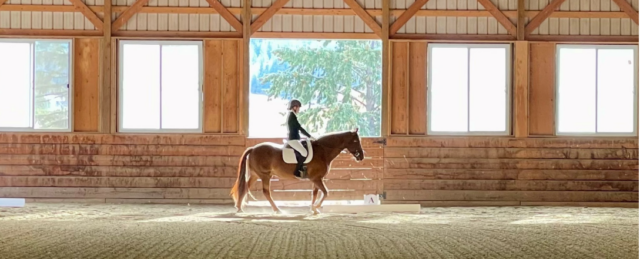
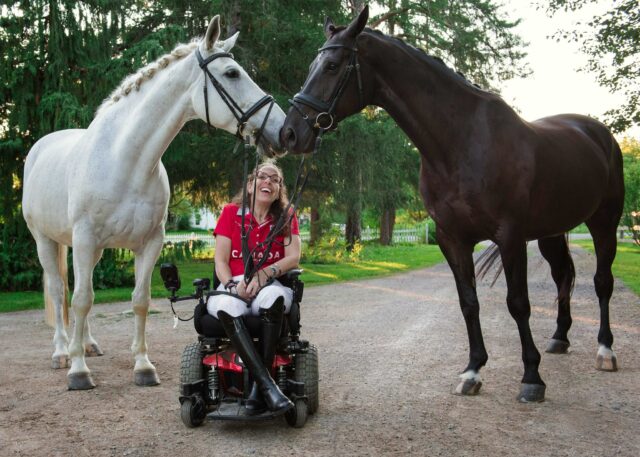
Forms and Documents
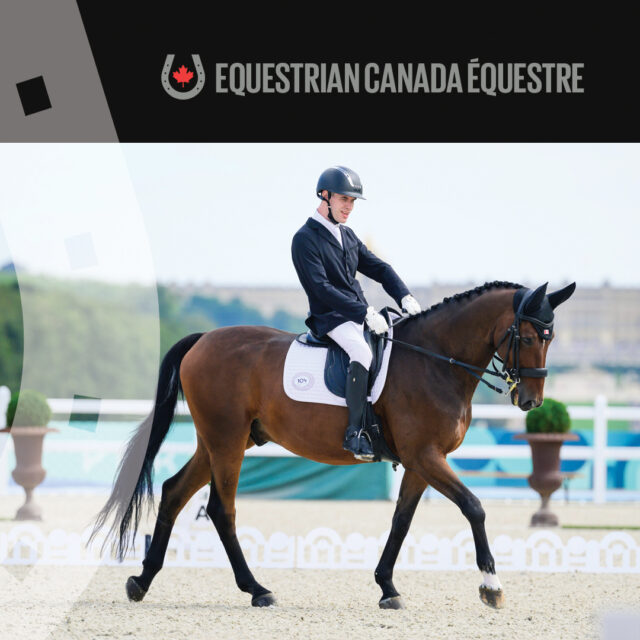
An introduction to Para Dressage
This educational module offers an introduction to Para Dressage, including how athletes are classified for competition and the role of compensating aids in training and competition.

Para Dressage National Championships
Find current rankings, criteria and information sheets for the Para Dressage National Championships here.

The Power of Para Dressage
From Therapy to Podium
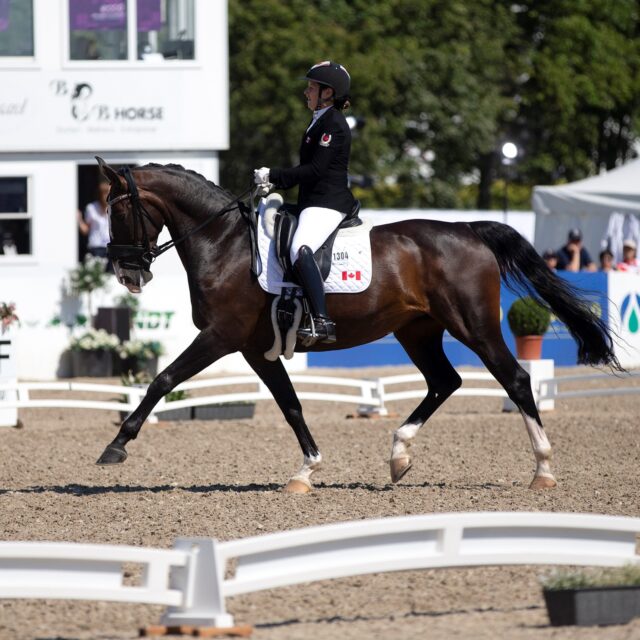
Apply for Grants
Apply for bursaries to elevate your equestrian future, including the Lauren Barwick Bridging the Gap Training Bursary.

High performance
Programs, ranking and support for the Canadian Equestrian Team.
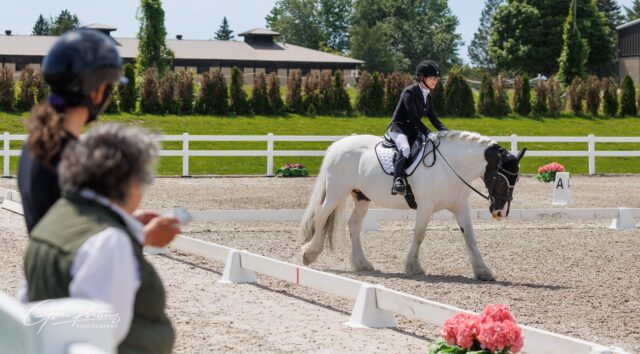
Athlete Development
EC facilitates the following programs for up-and-coming young athletes to support development and talent identification.

National Ranking
The aim of this pilot program is to encourage participation in EC Sanctioned para dressage competitions, to highlight athletic excellence at the national level, and to enhance unity in the sport of para dressage across Canada through the creation of an inclusive opportunity for national competition.
Awards
The EC Para-Dressage Committee provides a variety of recognition programs for the para-dressage community in order to recognize outstanding athletes, owners, horses, volunteers and more. Check out the available para-dressage recognition programs!
Para Dressage FAQ
The Para Dressage Video Competition Series provides riders of all levels and abilities with the opportunity to experience competition conditions in the comfort of their home stable and on a familiar horse. Participants compete against riders with similar abilities nationwide by submitting videos that are judged by Equestrian Canada (EC) certified Dressage Judges.
Video competitions encourage para-dressage riders to develop effective skills and provide them with an opportunity to compete in a progressive and structured environment. They are a fantastic way to ensure that all riders across Canada, no matter how geographically isolated, have the chance to compete. Competition is an integral part of athlete development and provides riders with new goals, as well as a sense of empowerment and accomplishment.
Para dressage provides athletes with a physical or visual impairment the opportunity to compete against other athletes with similar abilities. Athletes are classified and given a “Grade” based on their functional ability and are then judged on their riding skill against other athletes of the same Grade. There are five (5) Grades of competitions in para-dressage: Grade I represents the more severely impaired athletes and Grade V represents the least severely impaired.
At each Grade, athletes may receive approval to use specific compensating aids during competition, which will be listed on the athlete’s classification profile. The purpose of compensating aids (sometimes known as adaptive tack or specialized equipment) is to level the competitive playing field. Examples of compensating aids include rubber bands to stirrups or two whips. While compensating aids are varied and can be unique to an athlete, they should never provide an advantage.
Many para dressage athletes also compete alongside dressage competitors in EC sanctioned competitions. All athletes with physical or visual impairment who intend to enter EC Silver and Gold competitions must be classified by an EC Para Equestrian Classifier.
To learn more about the Para Dressage Classification Pathway, click here.
The Equestrian Canada Para Dressage Competition Pathway was developed to provide a structured progression for athletes who want to develop their skills and advance through the levels of competition. The framework provides a road map for athletes who wish to compete in para dressage at any level, from grassroots to international competition. The pathway indicates which tests should be performed at each stage of the pathway and when athletes need to get classified.
The pathway has four phases. Athletes set their own competition goals and progress at their own speed through the pathway. While some athletes may progress through all four phases to elite competition, others may choose to remain in a phase indefinitely.
The four phases are:
- Introduction to sport: Foundational stage for athletes new to para dressage. Introduces athletes to the sport, while developing basic skills and fostering the love of competition. Prepares athletes for national level competitions in a supportive low-pressure environment and provides competitive experience in a structured manner.
- Talent identification: Supports athletes identified as having the potential to excel. Prepares athletes for international competition. Athletes in this phase are focused on competing at the CPEDI2* level.
- Development: Helps competent competitors refine their skills, expand their knowledge, and improve their overall performance to compete at the CPEDI3* level.
- National: Focuses on high performance, elite level competition, including the Paralympic Games and World Championships. Supports athletes with the resources, coaching, and systems necessary to perform at the highest levels of competition on the global stage.
To learn more about the Equestrian Canada Para Dressage Competition Pathway, click here.
Para-dressage athletes are classified into Grades based on functional ability in areas such as muscle power, joint range and coordination. This allows for fair competition judged on skill and not level of impairment.
The Grades for para-dressage are classified as follows as per the FEI:
- Grade I – Athletes in Grade I have severe Impairments affecting all limbs and trunk. The Athlete usually requires the use of a wheelchair. They may be able to walk with an unsteady gait. Trunk and balance are severely impaired.
- Grade II – Athletes in Grade II have either a severe Impairment of the trunk and minimal Impairment of the upper limbs or moderate Impairment of the trunk, upper and lower limbs. Most Athletes in this Grade use a wheelchair in daily life.
- Grade III – Athletes in Grade III have severe Impairments in both lower limbs with minimal or no Impairment of the trunk or moderate Impairment of the upper and lower limbs and trunk. Some Athletes in this Grade may use a wheelchair in daily life.
- Grade IV – Athletes in Grade IV have a severe Impairment or deficiency of both upper limbs or a moderate Impairment of all four limbs or short stature. Athletes in Grade IV are able to walk and generally do not require a wheelchair in daily life. Grade IV also includes Athletes having a visual Impairment equivalent to B1 with very low visual acuity and/or no light perception.
- Grade V – Athletes in Grade V have a mild Impairment of movement or muscle strength or a deficiency of one limb or mild deficiency of two limbs. Grade V also includes Athletes with visual Impairment equivalent to B2 with a higher visual acuity than visually impaired Athletes competing in Grade IV and/or a visual field of less than 5 degrees radius.
Compensating (adaptive) aids can be used by athletes to compensate for physical or sensory limitation resulting from their impairment, thereby enabling them to ride a horse safely. A compensating aid is not to be used to compensate for lack of riding skill or to enhance the horse’s performance, which would be considered a training aid. The well-being of the horse is paramount in considering the use of any compensating aid.
Please reference the FEI Para Dressage Compensating Aids List and the FEI Classifiers Manual to find out what compensating aids are allowed per classification grade.
Request Form for Non-Standard Compensating Aids for EC Para- Dressage Competitions
Athletes with a physical or sensory impairment who use compensating aids and compete at EC sanctioned competitions must be listed on an EC master list that identifies which compensating aids are permitted in competition. These lists include the EC Dressage/Para-Dressage Dispensation Master List (Bronze competitions) and the EC Para-Dressage Classification Master List (Silver/Gold competitions).
It is the responsibility of each competitor and coach to ensure all compensating aids used in competition have been documented correctly on the appropriate list. EC will be responsible for maintaining the two lists to include up-to-date and strictly relevant details. The lists will be updated monthly or as required.
EQUESTRIAN CANADA DRESSAGE AND PARA DRESSAGE COMMITTEE
The EC Dressage and Para Dressage Committee is responsible for leading the strategy on programs and services for dressage and para dressage development in Canada.



